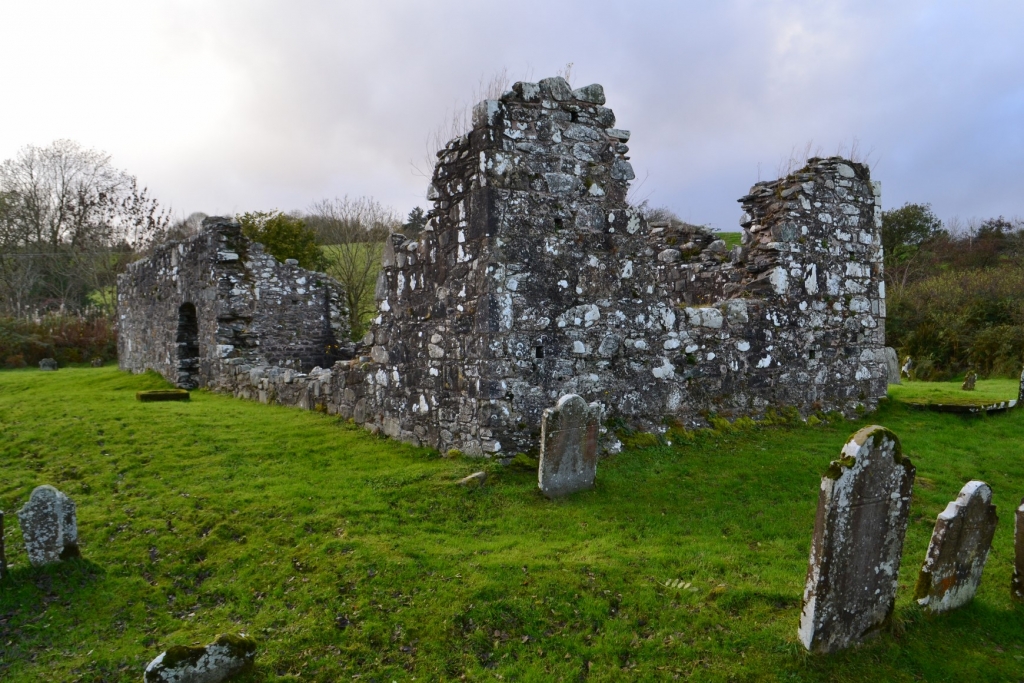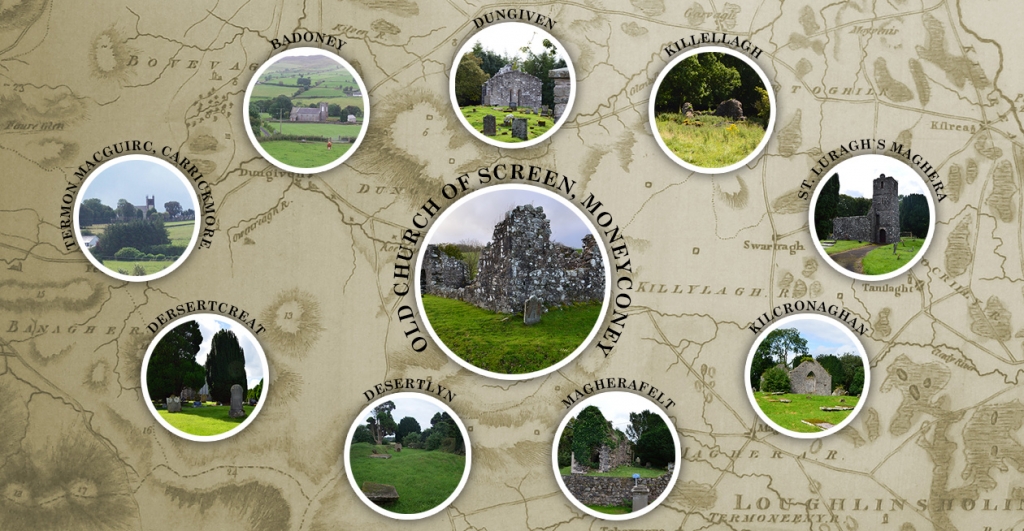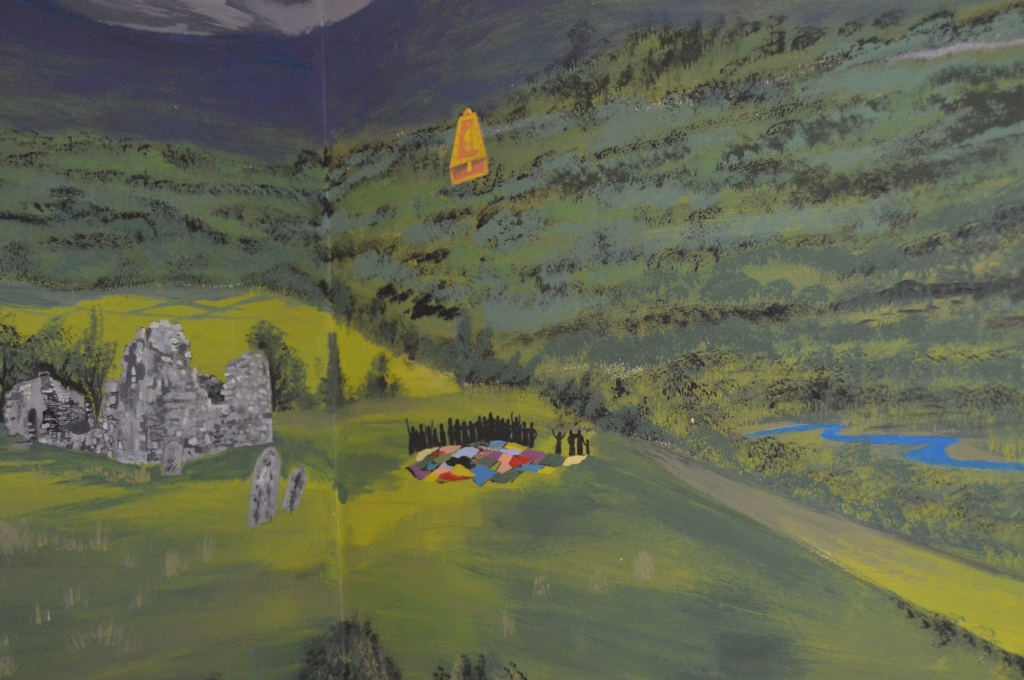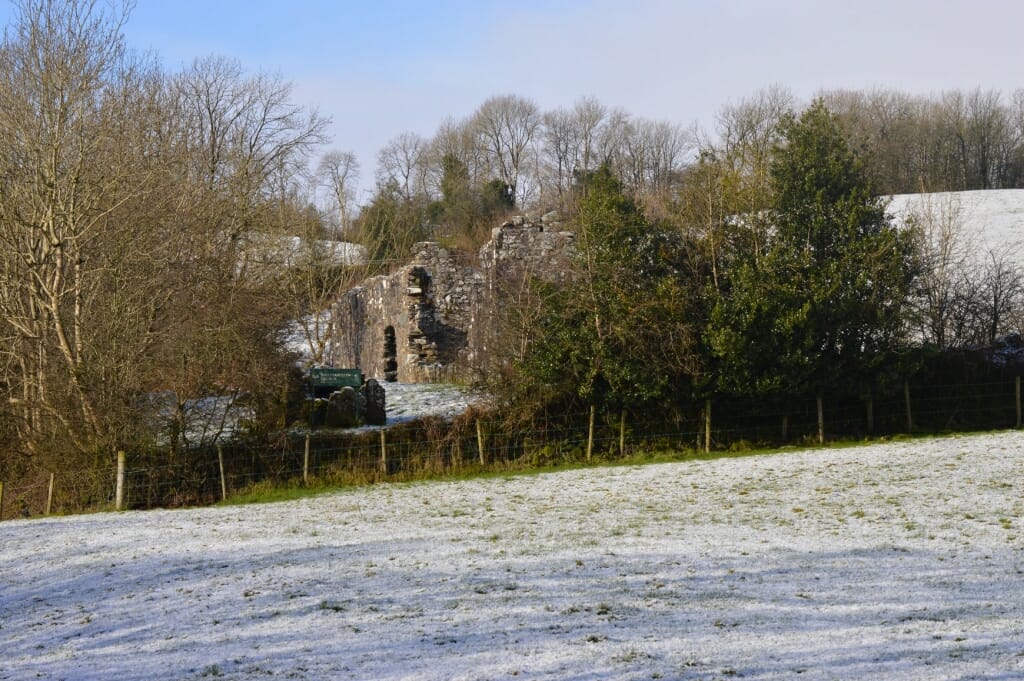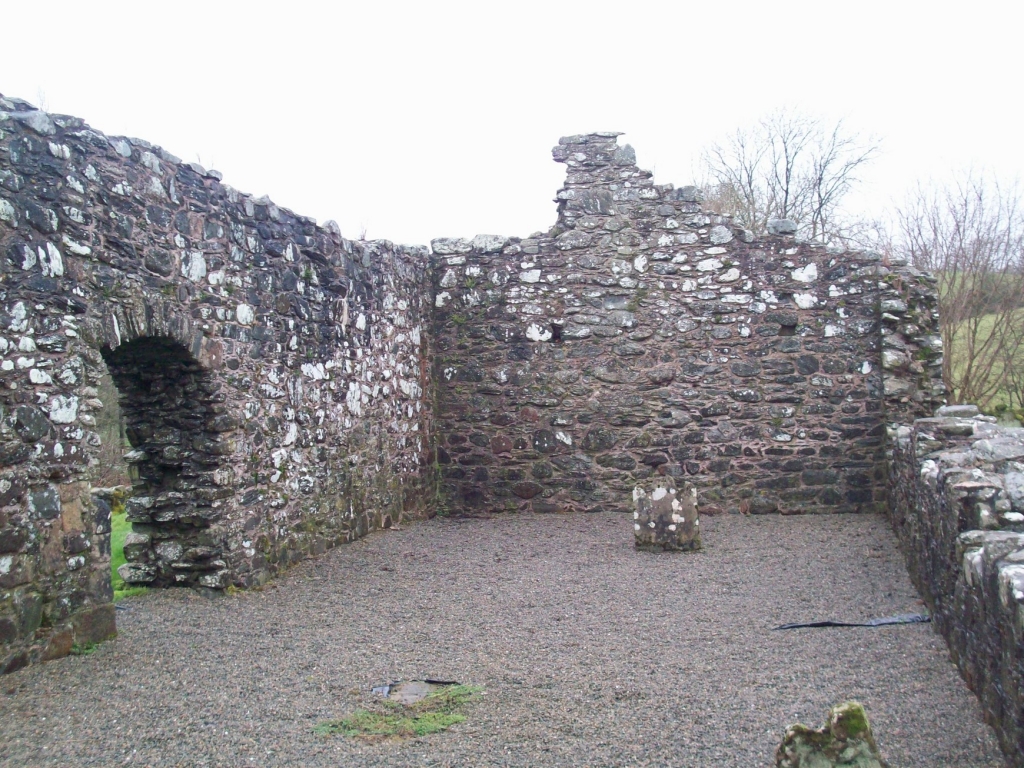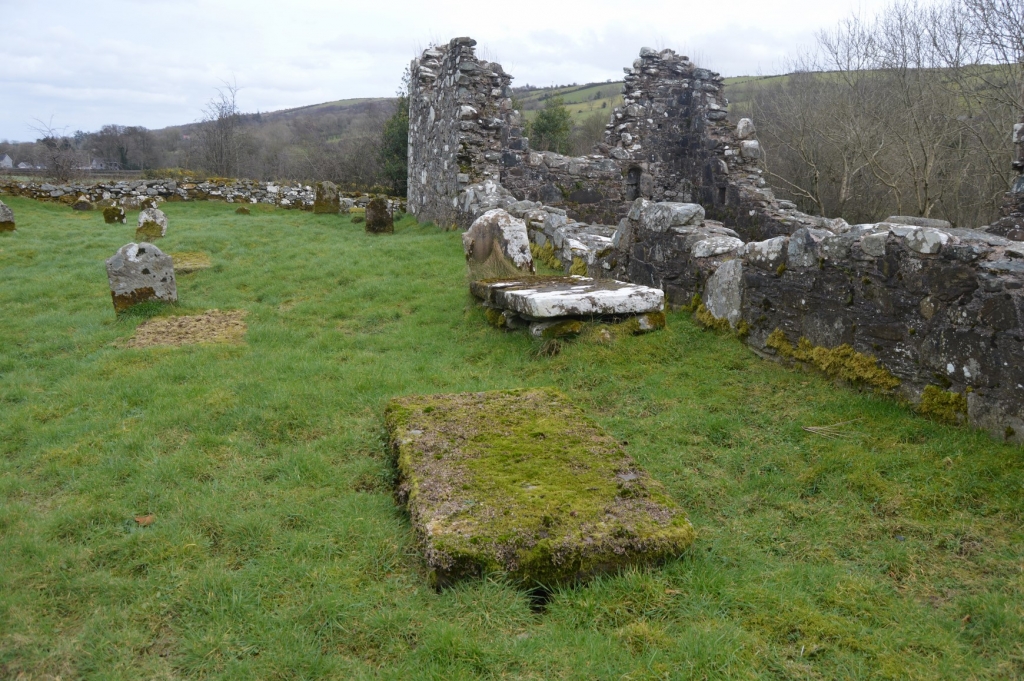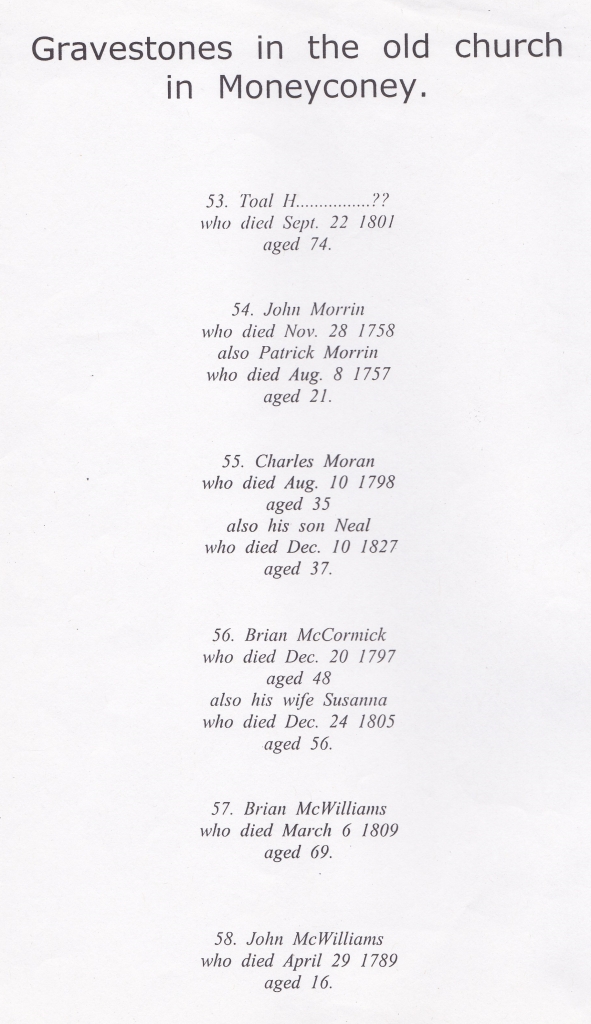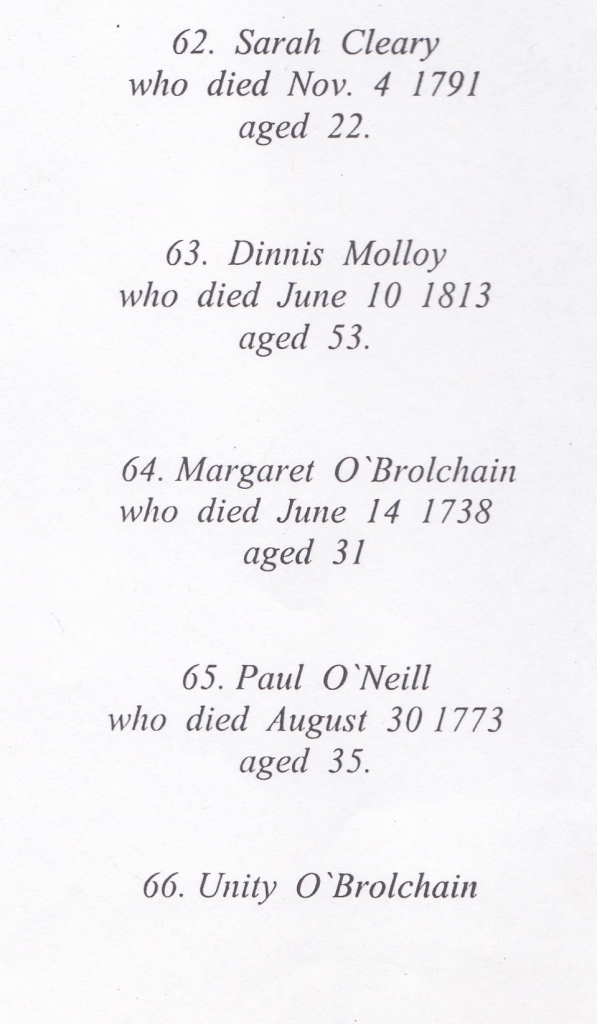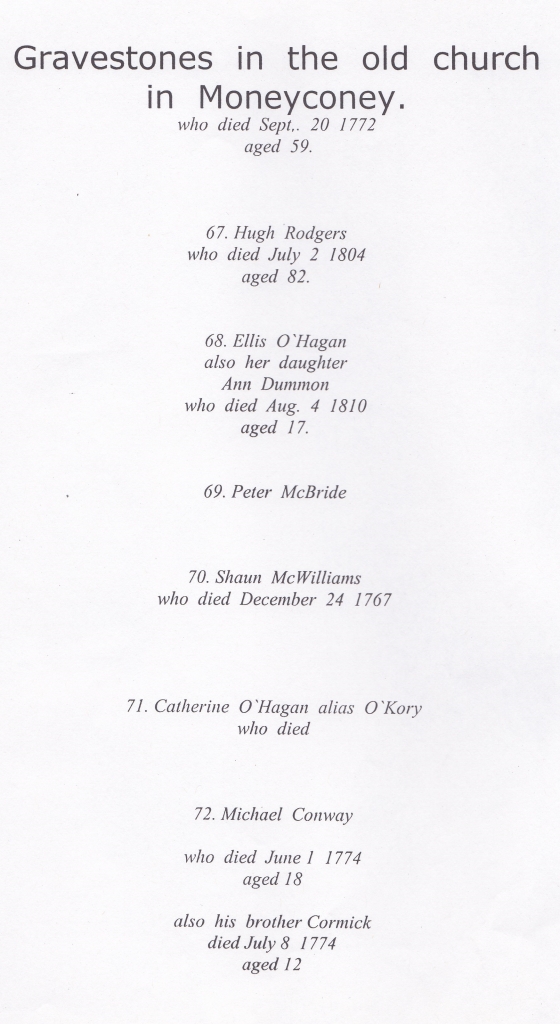The old church of Scrine.
The parish of Ballinascreen takes its name from the old church at Moneyconey in the Sixtowns.
No one knows when the old church of Scrine was founded and there is an overdependence on legend and ancient folklore to find out when it was. One thing which is fairly certain, is that it dates back a thousand years at least. Legend tells us that St. Patrick founded it, firstly as a church, and then St Colmcille converted it into a library. While this would be a theory which all of us would like to have been true, it is most unlikely that both these venerable men ever set foot in the area. There are church buildings in every corner of Ireland, which are supposedly founded by either or both of these men. It would be quite a feat even nowadays for the same person to found so many churches and places of worship in the short period of time that St. Patrick and St. Colmcille had available to them. However, it would not be unreasonable to believe that a religious sect set up by either saint could have been responsible for founding a church like that of Scrine.
The word “scrinium” in Latin means box or library and the Irish word “scrine” means the same thing. Hence we get Baile na Scrine which means “the town of the library” or Ballinascreen in English.
The nine mile Churches.
The church was the centre piece of nine other churches which were nine Irish miles distant from it. These were Badoney,Dungiven,Killelagh, Maghera, Kilcronaghan, Magherafelt, Desertcreat, Termonmagurk and Desertlynn. They were called “timpeall na nocht mile” or the nine mile churches.
There was a particular reason why these churches were founded within nine miles of Ballinascreen church. In those days books were very scarce and precious so they had to be stored, not only in a safe place, but where they would be accessible to each of the churches .i.e. no more than nine miles away. The isolated location of the Ballinascreen church at the top of the thickly wooded Glenconkyne which was what is now the parishes of Ballinascreen and Desertmartin meant that it would have been very difficult for any would be raiders to find. Nonetheless, one raider found it, probably because he came over the mountains from Tyrone.
The saga of O`Neill and McLaughlin`s bard.
The Annals of the Four Masters, an ancient account of the history of Ulster, tells us that in the year 1203 A.D. a chieftain of the McLaughlins of Donegal came raiding churches across Tyrone with his band of mercenaries and raided the church of Screen. However he must have sat around for too long admiring his work because he was soon caught up with by a local O`Neill chieftain and his men and a battle took place on a sand esker or ridge south of the church, afterwards known as Eiscir Mhic Lochlainn or McLaughlin`s ridge. This hill is no longer mentioned in the locality but is likely to have been the hill behind Loughrans/McBrides on the Crockban road in Altayeskey. Another possible site could have been the “shillin hill” where the Tullybrick and Sixtowns roads meet. McLaughlin was defeated and killed in the ensuing battle and his men put to flight. There is a place close to the former site called Bealnaslaght which means The mouth of the burial place and this might refer to McLaughlin`s grave.
There is a very interesting story told about McLaughlin`s poet, McNamee. After the battle was over and O`Neill was victorious, McNamee asked him if he could come over to his side and become his poet.(In those days each chieftain would have had a professional poet to write nice things about him) O`Neill had no time for this poet but he decided to string him along anyway. He told the poet to climb on to his horse behind him and he would give him a lift. In order to impress his new master and show his new found allegiance, McNamee told O`Neill to pull his horse over to “this boor” i.e. McLaughlin`s dead body so he could use it to step up onto his new master`s horse. O`Neill made a bargain with McNamee that if he worked for three years for him that he would pay him well. However, three years later, after writing endless poems and tributes to his chieftain, McNamee still had not received a penny from him in payment. He approached O`Neill one day about this and O`Neill told him that before he would pay him there was one last thing that he needed him to do. He wanted him go down to the fort of his cousin to ask him a question. Now, this character was a well known pscyopath who used to hang anyone whom he did not like. O`Neill knew that this man would soon put an end to his poet, so his plan was to send him down on some sort of meaningless errant and his fate would be sealed. However, McNamee was a crafty man too and he asked O`Neill how he would be able to verify if he actually asked the question. O`Neill told him that he would send his own son to make sure that he would ask. When they arrived at O`Neill`s cousin`s place, the old rascal interviewed the poet and realising that O`Neill was up to his antiques again and that he was trying to use him to do his dirty work, he decided to teach him a lesson so he hanged his son and set the poet free.
It is an interesting story, connected to the history of the church of Ballinascreen which gives us an insight into what some of the people of that time were like.
Local folklore and the Old Church.
There has always been a great tradition of legend and mythology among the Irish people and aside from the feel good factors which they engender in us about events of our past, they also carried a cryptic message or symbolism about the happenings at the time of their origin. This is why, although we take these stories with a pinch of salt, we should also look for what this symbolism means when referring to events in our history.
For example, we are told about the difficulties which were encountered in finding a site for the building of the church. Several sites were tried but each time, the building would be torn down by a monster or `peist`. This may allude to the opposition to the new church and its beliefs by the local druids. It is well known that when Christianity began to establish itself in Ireland, ancient pagan religious sites were used to build churches and places of pilgrimage on. There were two possible reasons for doing this. Firstly, the site was already looked on by the people as a holy site and secondly, the church were prudent enough to work go some way along with the old pagan ways rather than try to face them down. The idea was to draw them into the Christian faith rather than to try to force the issue. This is why so many pagan traditions and beliefs survived right up until recent times in Ireland. Now we can understand the position of some of the druids who would have seen Christianity as being a threat to their religion and way of life. The most natural reaction would be to tear down any building which was being built on hitherto believed to be sacred sites. Perhaps the story was trying to simplify the reasons why the walls were being torn down each night by blaming it on a mysterious monster. That way, there would then be no finger pointing or aggro between the pagans and the Christians. On the other hand the story may just have been composed by old storytellers in the ancient tradition. It is interesting to note that the site was finally chosen in a place where it would come to no further harm, just across the river Moyola in the townland of Moneyconey. There would have been lots of ancient burial stones and stone circles in the two townlands in which it had been attempted to build the church, namely Owenreagh and Cavanreagh. Coincidently, there were no such pagan relics on the north bank of the river, in places like Moneyconey. Is this the reason why they finally got a spot to build on which would not be attacked? Was this site situated outside the area for long controlled by the druids? There is another story told about the choosing of the site which, while it refers to the choosing of the site, also has a symbolic message which was associated with a period much later in history.
Another piece of folklore about the Old Church is that it was built by St. Patrick as a church but later converted to a monastery by St. Colmcille. This fable is really an attempt to explain a change in the local veneration of these two saints at a time.
Around the end of the first millennium, there was a change of tribal power in south Derry and the people who took over saw St. Colmcille as their saint and so there was a switch of veneration of St. Patrick to St. Colmcille. This happening was explained in folklore by the story of the change of purpose of the church which rendered it unnecessary to explain the ins and outs of the tribal power struggles of the time.
The Bell and the Cloaks.
This painting by Stephen McGuigan (Ballinascreen), shows the people waiting on the bell to fall from the heavens, having spread their cloaks out on the ground.
Tradition has it that while trying to find a site for the church, the people got a message that a bell would descend from the heavens and that the place where it would land would be the spot where the church would be built. After hearing the pealing of the bell in the sky above for some considerable time, the people were told to spread out their garments on the ground to provide a soft landing for the it. Eventually the bell hurtled towards the ground and it landed on McGillian`s garment but turned over and rested on that of McGurk. It was claimed there after that the two families were forever in dispute as to which were to be the keepers of the bell. In fact it was the McGurks who held it in the end. It is an interesting story but it is most likely that this story was made up at a much later date, possibly after the 12th or 13th century. When that area came under the control of the O`Neill,the church would have been looked after by the McGurks, as they were the traditional erenaghs of the O`Neills. Perhaps this story set out to symbolise the rivalry which existed between the McGurks and the McGillians for which of them were the rightful erenaghs. It is believed that the bell from the old church of Scrine was taken up to Termonmacguirk after the Flight of Earls in 1604.This would suggest that the McGurks were the erenaghs at that time.It is also interesting to see that a survey of the parishes and chapels in 1607 found that there was no erenagh in Ballinascreen church but that there was a vicar by the name of Sean McGillian. So, what was the connection between these two families or what was their role in the church during the previous centuries. This old folklore makes some attempt to draw our attention to the issue but in the end, leaves us no wiser.
How long has the church been around for?
The oldest written reference which we have to the church of Ballinascreen comes from the Annals of the Four Masters. It refers to the raid on the church of Scrine by a Dermot McLaughlin in the year 1203, which I have recounted in some detail elsewhere in this book. The church must have been quite a significant place and well known for McLaughlin to know where it was and that it was worth raiding. It is also interesting to find that the church was well policed by the O`Neills at the time. They were able to come to its rescue and defeat the raiders. This was around the time that the O`Neills were wresting control of this area from the McLaughlins. They would have by then had their erenagh in place in Ballinascree. The role of the erenagh was to look after the upkeep of the church and any other duties which the bishop felt necessary. The land around the church would belong to the erenagh and would be used to fund any expenses incurred thus. The Sixtowns was erenagh lands and those people who lived on it had to pay rents and dues to the erenagh who in turn had to make payments to the bishop.
The church gets an eminent visitor.
The next written reference to the church of Scrine was in Primate Colton`s Visitation to Derry in 1397. He was sent by the king of England to do a survey on the state of the churches in that part of Ireland. On his journey back he stayed overnight in Banagher and then made his way through the wilds of the Glenelly Mountains to his destination at Desertcreat. It is almost certain that he passed or even stopped over at Moneyconey. These churches were spaced out seemingly at distances which meant that any pilgrim making his way across the country, say from Derry to Armagh would have staging posts along the way, since travelling was slow and hazardous in those days. It is also believed that during the Flight of Earls in 1607, Hugh O`Neill and his family entourage ,made their way from Tullyhogue to Rathmullan , actually passed close to and even may have stopped over at the church of Scrine. It would have been about a decent days travel from Tullyhogue to the Sixtowns and after resting up there overnight they could have headed out through the gap at Glengamna and down through Glenelly to Badoney church which would be a days walk further along the journey. Stories such as these give us a picture of the standing which the church of Scrine had in the territory of the O`Neills in those times.
The Archbishop`s Report on the Church in 1397 A.D.
The Visitation to Derry reported that the country was in a very settled state at that time which would suggest that Ballinascreen church would have been operating at its full potential, unhindered. This must have been its golden era for in just over 200 years afterwards it would be lying in ruins. There is also mention in this survey of the rents and dues which the erenagh of Scrine church was paying to the bishop of the time. As well as monies paid by the whole parish the bishop received dues paid to him by the erenagh of Ballinascreen;
Rents £2 Episcopal Thirds £1 6s 8d
We are also informed that the erenagh lands of Ballinascreen are made up of six balliboes (sis townlands) and that the erenagh himself has one of these for himself free of rent.However, in return, he must bear the cost of the upkeep of the church or any other maintenance costs.
In a survey of the state of the churches in 1609, it was reported that there was no erenagh resident there and that the roof was off the building, suggesting that the church was no longer in use. There was a vicar, named McGillian listed as still being attached to the church which might infer that some sort of services were still in existence in one form or other.
Some time after the Flight of Earls, all the church lands and erenaghs which had been previously part of the lands of the various Ulster clans, were handed over to the Church of Ireland and most became the place of worship of the people who arrived with the Plantation of Ulster. The church of Ballinascreen would have been one of these churches and the first evidence which we have of there being new tenants comes from the Primates Visitation Book of 1679, some 70 years later. This time the church is reported as being in good repair which suggests that there had been a new roof put on and other repairs had been carried out in the intervening period, evidently for the new congregation. The rector was listed as Andrew Henderson and the curate was a John Browne. William Springham was listed as Parish Clerk.
New Church of Ireland building opens in Draperstown in 1760. Old Church abandoned.
In 1760 the new Church of Ireland was opened in Draperstown and became the site of worship for its followers in the parish. It is not known exactly how much the church at Moneyconey was used in the period from 1609 up to that year. It is noticeable though that there are no headstones of the Church of Ireland members, apparent in the old church graveyard which makes us ask where did they bury their dead? Did they not use headstones? The Catholics continued to bury their dead in the church graveyard right up until the early 1800`s.It asks a lot of questions about who was using the church and how was it being used during that period from 1609 up to 1760 and afterwards.
What did the Ordinance Survey Memoirs tell us about the state of the Old Church?
The Ordinance Survey Memoirs provide us with some information on the old church in the 1830`s.
The old church of Ballinascreen lies on the northern side of the new road leading from Moyheelan to Greencastle in Tyrone and about 3 miles from the former.It was an oblong building of about 66 feet by about 24 without turret or spire, and (a token of its antiquity) without division between nave and chancel. The gables and the north wall are nearly entire. The entrance in the south was spacious and surmounted by a Norman arch. The east window was large and lofty; its arch appears to have been pointed. On the epistle side of the altar is a small niche. It was built of the common landstone, except the coignes which are of a fine grained cut freestone. The cement is less hard than that of most old buildings, being probably made of the argillaceous lime from Cookstown. Indeed the people have a tradition that all the materials were brought over the Tyrone mountains.
Elsewhere it tells us that there were two windows on the western wall and one on the eastern wall. The door it seems was originally 3 feet wide but by that stage it was 6 feet 9 inches high and 5 feet wide, We are also informed that fragments of Gothic pillars were to be found mixed up in the masonry around the doorway. This would suggest that the building had been damaged or torn down at some stage and rebuilt from the rubble. There is a belief that indeed the church was rebuilt s a number of times throughout its period of existence. This might be some evidence of that having been the case.
Very importantly it states that the building had been roofed with shingles of oak timber up to about the year 1700 and that the bell hole in the gable was perfect right up until the year 1794. Here we have the next written report on the state of repair of the old church since the Primate`s Visitation report of 1679.This would indicate that the church was reroofed prior to 1679 and that by 1700 a large portion of it was gone. It would be interesting to know, how the church was used during the period when it was roofed, who used it and for what.
The O.S. Memoirs go on to say;
This edifice is said to have been erected by St. Patrick for a library, in Irish screne (scrinium), hence the etymon of Ballinascreen “the town of the library”. It appears to be the spot named Scrine in Glen kan ki, in the map of the Pacata Hibernia. St. Columb afterwards converted it into a church or more probably into a monastic institution, as it stands in the midst of the termon or erenagh lands, most of which are known to have been procured by his means as endowments to monasteries.
The author is probably quite right in his assertion here that the library was in fact converted into a monastic settlement. Its position in such a remote part of the parish would not suggest that it served as a church for its parishioners who would have lived some distance further away. It would be, because of its isolated position, more suited as a monastic site.
He continues;
His temporary residence (Bolea na Colmcille) during the alteration of the building is still pointed out on a neighbouring height.
This would seem to make reference to the connection between the old church and that area of Boulie and Lough Patrick, i.e. all three were recognised always as sites of religious nature. There is no doubt about the connection between these sites and this conection may go back to the start of Christianity in the area, when old pagan sites were adopted as well as some of the old pagan customs. Certainly the area around Lough Patrick was inhabited for long before the arrival of Christianity in the area. We shall see later on how some of these ancient traditions survived up until the end of the 19th century at least in this place.
He goes on to talk about the site of the church;
Whether as a monastery or a place of study, nothing could have been chosen with a better taste.The building from its sequestered site on the bank of a bright stream, with lofty mountains and narrow dark glens behind, the sleepy bank in front, broken with ravines or swelling into hills, the vale below stretching away in lovely expansion, was admirably suited to the solitude of study or the seclusion of monastic life; But as a church it must have always been an inconvenient distance from the great body of worshipers.It is sometimes designated in Irish by a name which implies “that it was 9 miles distant from 9 other churches”. It should be added that, according to tradition this church is the central one of the nine churches founded by St .Colmcille,viz. Ballynascreen, Desertlyn, Desertcreat, Termonmaguirk Killelagh, Badoney, Magherafelt,Maghera and Dungiven.
The central position of the Ballinascreen church must give it considerable status within that grouping. It is possible that at a time all the manuscripts or artefacts were kept there for safety, such was the secluded position of the church of Scrine.One way or another, this church had some role in relation to the other surrounding churches. Perhaps clergy from the other churches trained or studied there. Maybe these churches were administered from the church of Scrine. But then, was it a church atall ?
There is no doubt , from his poetic description of the place that the author is convinced that the site would be more suited to the seclusion of a monastic institution rather than it being a church which needs to be sited amidst the bulk of its congregation. He goes on to mention the story of the arrival of the bell and the subsequent rivalry between the McGillians and the McGurks over who should be in charge of the bell and how it was used to swear on and to settle disputes.
Hence the bell is called Dia Dheultagh or “ the vengence of God”. It is long, narrow, of a square form, very curiously embossed, and fame who loves the marvellous, tells that each of its sides once held a diamond of great value.It is certain that the sockets still remain in its sides, in which some rare stones may have been set by way of ornament. The bell is now removed to Tyrone.
There is a bell in the museum of Edinburgh which is believed to be the same bell although historians are at odds about whether it is or not the Bell of Ballinascreen.
In 1959, the Patrician Year, Parish Priest Fr. M. Collins decided to have a celebration mass at the church. He was prevented by the then Government authorities from celebrating mass inside the church, so a large wooden structure was built in Duffy`s field just outside the walls to act as an altar. Local men gathered to clean up the grounds and a lot of preparation was carried out for the Bishop of Derry to come and say mass. A huge crowd assembled for the celebrations and the field was almost full for the celebration.
Some images of the church grounds.

